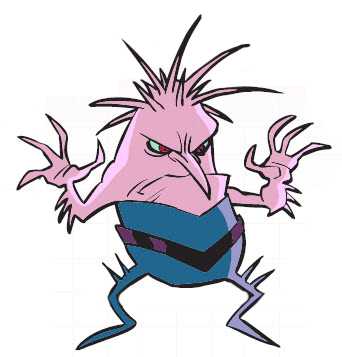Case file: The Spazzzoids
- Real name: tetanus
- Known aliases: lockjaw, clostridium tetani (the toxin that causes tetanus disease)
- Microbe type: bacterium

PROFILE
Tetanus is a real lowlife, skulking around the dirtiest places, waiting for the chance to infect someone. It hangs out in places like dirt or soil, and in the bowels (intestines) of animals and people. But, it gets to start an infection only when it finds a break in someone’s skin. Picture it. These bacteria are swarming all around in the dirt and on a rusty nail. A bare foot steps down. Ouch! And, with that, tetanus has found its way in. The days of lying in wait are over, and the days of actively infecting someone begin.
About 40 to 60 people get tetanus in the U.S. each year. We don’t know how many assaults tetanus actually launches, because immunized people are protected against it. Tetanus kills almost one-third of the people it infects.
POWERS & ABILITIES
This infector is a heartless attacker and killer. It causes severe muscle spasms, starting around the neck, chest, and back. Doesn’t sound too bad? These spasms can be so intense that they make it hard to breathe, and can even break bones! Tetanus can suffocate and kill. It also causes such intense stiffness that some infected people cannot open their mouths.
PREFERRED METHOD OF ATTACK
Tetanus attacks through any break in the skin, like a cut, scrape, or burn. To tetanus broken or raw skin looks like a huge door open wide.
Unlike many other infectors, tetanus does not have the ability to jump from one person to another. However, the disease can rear up whenever skin is broken—think about a dirty, open cut, or an animal bite, or even an infection after surgery.
KNOWN WEAKNESSES
Our protector is a tetanus “toxoid” by the name of Tetanospasmin (pronounced TET-no-SPAZ-min). To make this hero, scientists take the tetanus bacteria substance that makes people sick, called tetanus “toxin.” They “inactivate” it with chemicals so it can’t hurt anyone. This dead toxin is called a toxoid. The toxoid in the vaccine against tetanus teaches your immune system how to fight the infection, but won’t make you sick. The vaccine is virtually 100% effective—as long as the vaccinated person has had the proper vaccine dosage within the past 10 years.
A common way for kids to get their earliest tetanus vaccine is in a triple-protector vaccine called “DTaP” that protects against three diseases— diphtheria, tetanus, and pertussis.
If tetanus does infect someone, doctors help the immune system’s battle with medicine to fight the toxin. They also clean the wound and use medicines to control the body’s muscle spasms.
PREFERRED VICTIMS
In the U.S., tetanus lies in wait, keeping an eye out for unvaccinated people or people whose vaccine protection has worn off with time.
PRECAUTIONS FOR THE PUBLIC
Get the tetanus vaccine to teach your body how to ward off this predator. Because the vaccine’s protection doesn’t last forever, be sure to get tetanus “booster” shots. Boosters are needed about every 10 years.
But, don’t stop there. Be a clean freak. Clean all skin injuries completely with soapy water. Take extra special care to clean cuts from anything that’s been outside, such as dirty glass or rusty metal. Keep skin injuries covered to heal. Even if a scrape or burn doesn’t look dirty to you, remember that to tetanus it looks like a big doorway into your body.
AREA OF OPERATIONS
This evildoer lurks in its favorite filth worldwide. But, tetanus bacteria love hot, damp places with lots of people living close together.
CRIMINAL RECORD
Doctors started giving kids tetanus vaccine as a part of basic health care in the 1940s. Back then, tetanus successfully infected about 500 to 600 people every year in the U.S. Even though tetanus still lies in wait in dirty places, its infecting career is somewhat less successful these days. Only about 40 to 60 people get infected in the U.S. each year.
The vaccine hero, Tetanospasmin (the toxoid in tetanus vaccine that protects us), had one of its biggest known successes against the enemy tetanus back during World War II. U.S. soldiers were at great risk of getting wounds that could not be cleaned well in battle conditions. But, their tetanus immunization protected them. Only 12 soldiers were infected—and, it turned out that half of them had actually not been vaccinated at all. Other country’s soldiers who were not vaccinated were much more likely to get infected with tetanus.
Immune Platoon Disease Database
- Page last reviewed: August 28, 2017
- Page last updated: August 28, 2017
- Content source:



 ShareCompartir
ShareCompartir